 W
WThe 1929 Timber Workers strike was a labour dispute in Australia caused by Justice Lukin of the Arbitration Court handing down an industrial award decision on 23 December 1928 to reduce the wages and increase the hours for 20,000 timber workers from a 44-hour week to a 48-hour week. It was the first strike in Australia after the onset of the Great Depression.
 W
WThe American Wood Council (AWC) is a trade association that represents North American wood products manufacturers.
 W
WThe Anderson Lumber Company property, roughly bounded by Brown, First, and Holland Streets in Philipsburg, Montana, was listed on the National Register of Historic Places in 1986.
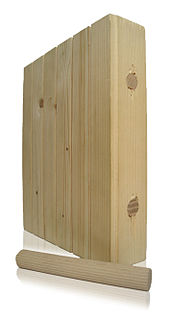 W
WBrettstapel, also known as dowellam, is a massive timber construction system, fabricated exclusively from softwood timber posts connected with hardwood timber dowels. It is a relatively simple method of construction that exploits low grade timber, not normally suitable for use in construction, to form load bearing solid timber wall, floor and roof panels.
 W
WThe Canada–U.S. softwood lumber dispute is one of the largest and most enduring trade disputes between both nations. This conflict arose in 1982 and its effects are still seen today. British Columbia, the major Canadian exporter of softwood lumber to the United States, was most affected, reporting losses of 9,494 direct and indirect jobs between 2004 and 2009.
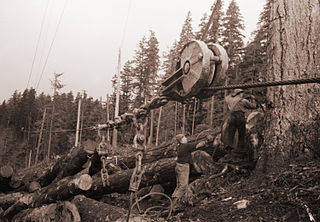 W
WA choker setter or choke setter is a logger who attaches cables to logs for retrieval by skidders or skylines. The work process involves the choker setter wrapping a special cable end (choker) around a log and then moving clear so the yarding engineer can pull the log to a central area. In clearcutting, fallers will typically cut down all the trees and limb and buck them into logs before the choke setters and others arrive to remove the logs.
 W
WA steam donkey or donkey engine was a steam-powered winch once widely used in logging, mining, maritime, and other industrial applications.
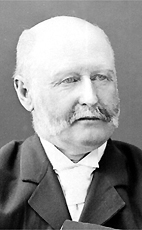 W
WWilliam Cameron Edwards was a Canadian businessman and parliamentarian.
 W
WEucalyptus urophylla, commonly known as Timor white gum, Timor mountain gum, popo or ampupu, is a species of eucalypt native to islands of the Indonesian Archipelago and Timor.
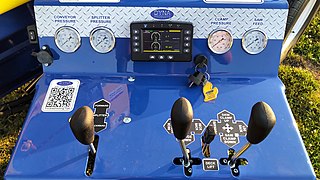 W
WA firewood processor is a machine designed to cut and split firewood with minimal manual handling of the logs. There are typically four main parts of the machine, each dedicated to a separate function. Processing begins with a log pile – a pile of logs that have been de-limbed and cut to an appropriate length, generally 10–12 feet (3.0–3.7 m). Popular brands include Multitek, Wood Beaver, DYNA, Hakki Pilke, and Blockbuster. Many individuals use processors commercially and also privately as a hobby. Others choose to rent them as an alternative to purchasing.
 W
WA forest product is any material derived from forestry for direct consumption or commercial use, such as lumber, paper, or forage for livestock. Wood, by far the dominant product of forests, is used for many purposes, such as wood fuel or the finished structural materials used for the construction of buildings, or as a raw material, in the form of wood pulp, that is used in the production of paper. All other non-wood products derived from forest resources, comprising a broad variety of other forest products, are collectively described as non-timber forest products (NTFP). Non-timber forest products are viewed to have fewer negative effects on forest ecosystem when providing income sources for local community.
 W
WThe Forest Stewardship Council (FSC) is an international non-profit, multistakeholder organization established in 1993 that promotes responsible management of the world's forests. It is an example of a market-based certification program used as a transnational environmental policy.
 W
WThe Forest Stewardship Council (FSC) is an international non-profit, multistakeholder organization established in 1993 that promotes responsible management of the world's forests. It is an example of a market-based certification program used as a transnational environmental policy.
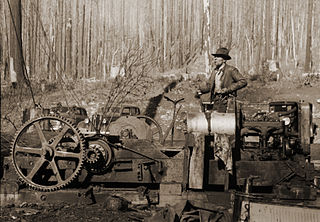 W
WA gyppo or gypo logger is a logger who runs or works for a small-scale logging operation that is independent from an established sawmill or lumber company. The gyppo system is one of two main patterns of historical organization of logging labor in the Pacific Northwest United States, the other being the "company logger".
 W
WHardwood is wood from dicot trees. These are usually found in broad-leaved temperate and tropical forests. In temperate and boreal latitudes they are mostly deciduous, but in tropics and subtropics mostly evergreen. Hardwood contrasts with softwood.
 W
WMohamad "Bob" Hasan was an Indonesian businessman, who served briefly as trade and industry minister in 1998 and was later jailed for corruption. He was one of the most prominent ethnic Chinese cronies of long-serving Indonesian president Suharto and was nicknamed "the plywood king" because of his forestry businesses. Hasan served as the chairman of the Indonesian Athletics Association from September 1984 until his death.
 W
WThe Hatton-Brown organization in Montgomery, Alabama, dates back to 1948, when local newspaperman Hartwell Hatton founded Hatton Publications at age 49. His first forest-oriented magazine, Alabama Lumberman, was published from 1949 to 1957.
 W
WHillerich & Bradsby Company (H&B) is an American manufacturing company located in Louisville, Kentucky that produced baseball bats for Wilson Sporting Goods, which commercialises them under the "Louisville Slugger" brand.
 W
WJesse Holman Jones was an American Democratic politician and entrepreneur from Houston, Texas. Jones managed a Tennessee tobacco factory at age fourteen, and at nineteen, he was put in charge of his uncle's lumberyards. Five years later, after his uncle, M. T. Jones, died, Jones moved to Houston to manage his uncle's estate and opened a lumberyard company, which grew quickly. During this period, Jesse opened his own business, the South Texas Lumber Company. He also began to expand into real estate, commercial building, and banking. His commercial building activities in Houston included mid-rise and skyscraper office buildings, hotels and apartments, and movie theaters. He constructed the Foster Building, home to the Houston Chronicle, in exchange for a fifty percent share in the newspaper, of which he acquired control in 1926.
 W
WHenry Hamilton Love was a lumberman, sportswriter and humorist who lived in Nashville, Tennessee. He was known as the "Daddy of the Nashville lumberman" and was the first president of the Nashville Lumberman's Club. Love wrote the Hardwood Code, a telegraphic code once used extensively in the lumber trade and that was urged by the Hardwood Manufacturer's Association of the United States.
 W
WLumber, also known as timber, is wood that has been processed into beams and planks, a stage in the process of wood production. Lumber is mainly used for structural purposes but has many other uses as well.
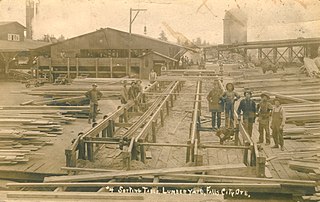 W
WA lumber yard is a location where lumber and wood-related products used in construction and/or home improvement projects are processed or stored. Some lumber yards offer retail sales to consumers, and some of these may also provide services such as the use of planers, saws and other large machines.
 W
WThe Missouri Lumber and Mining Company (MLM) was a large timber corporation with headquarters and primary operations in southeast Missouri. The company was formed by Pennsylvania lumbermen who were eager to exploit the untapped timber resources of the Missouri Ozarks to supply lumber, primarily used in construction, to meet the demand of U.S. westward expansion. Its primary operations were centered in Grandin, a company town it built starting c. 1888. The lumber mill there grew to be the largest in the country at the turn of the century and Grandin's population peaked around 2,500 to 3,000. As the timber resources were exhausted, the company had to abandon Grandin around 1910. It continued timber harvesting in other parts of Missouri for another decade. While some of the buildings in Grandin were relocated, many of the remaining buildings were listed on the National Register of Historic Places in 1980 as part of the state's historic preservation plan which considered the MLM a significant technological and economic contributor to Missouri.
 W
WMoisture meters are used to measure the percentage of water in a given substance. This information can be used to determine if the material is ready for use, unexpectedly wet or dry, or otherwise in need of further inspection. Wood and paper products are very sensitive to their moisture content. Physical properties are strongly affected by moisture content and high moisture content for a period of time may progressively degrade a material.
 W
WThe National Hardwood Lumber Association (NHLA) was founded on April 8th, 1898 in Chicago, Illinois to establish uniformity of inspecting hardwood lumber. The NHLA is now a membership-based trade association that serves two main purposes: to stimulate economic activity and to provide a vehicle for the members to collectively strive for mutual benefit. The NHLA has continued to be a national voice for the hardwood industry.
 W
WThe Ottawa River timber trade, also known as the Ottawa Valley timber trade or Ottawa River lumber trade, was the nineteenth century production of wood products by Canada on areas of the Ottawa River and the regions of the Ottawa Valley and Western Quebec destined for British and American markets. It was the major industry of the historical colonies of Upper Canada and Lower Canada and it created an entrepreneur known as a lumber baron. The trade in squared timber and later sawed lumber led to population growth and prosperity to communities in the Ottawa Valley, especially the city of Bytown. The product was chiefly red and white pine.The Ottawa River being conveniently located with access via the St. Lawrence River, was a valuable region due to its great pine forests surpassing any others nearby. The industry lasted until around 1900 as both markets and supplies decreased, it was then reoriented to the production of wood pulp which continued until the late 1990's/early 2000's.
 W
WA pulp mill is a manufacturing facility that converts wood chips or other plant fiber sources into a thick fiber board which can be shipped to a paper mill for further processing. Pulp can be manufactured using mechanical, semi-chemical, or fully chemical methods. The finished product may be either bleached or non-bleached, depending on the customer requirements.
 W
WQ-pits are kiln sites which were dug for the production of white coal prior to the Industrial Revolution when white coal was largely superseded by the use of coke.
 W
WResistograph is a mechanical resistance measurement device, developed by Frank Rinn.
 W
WThe Ryan & Company Lumber Yard is a historic site in Apopka, Florida. It is located at 215 East Fifth Street. On February 25, 1993, it was added to the U.S. National Register of Historic Places.
 W
WA saw pit or sawpit is a pit over which lumber is positioned to be sawed with a long two-handled saw by two people, one standing above the timber and the other below. It was used for producing sawn planks from tree trunks, which could then be cut down into boards, pales, posts, etc. Many towns, villages and country estates had their own saw pits. The greatest user of sawn timber in past centuries was the shipbuilding industry.
 W
WA sawmill or lumber mill is a facility where logs are cut into lumber. Modern sawmills use a motorized saw to cut logs lengthwise to make long pieces, and crosswise to length depending on standard or custom sizes. The "portable" sawmill is of simple operation. The log lies flat on a steel bed, and the motorized saw cuts the log horizontally along the length of the bed, by the operator manually pushing the saw. The most basic kind of sawmill consists of a chainsaw and a customized jig, with similar horizontal operation.
 W
WA shingle weaver (US) or shingler (UK) is an employee of a wood products mill who engages in the creation of wooden roofing shingles or the closely related product known as "shakes." In the Pacific Northwest region of the United States, historically the leading producer of this product, such shingles are generally made of Western Red Cedar, an aromatic and disease-resistant wood indigenous to the area. The use of the term "weaver" for a shingle maker related to the way in which the workers fitted the shingles together in bundles but the meaning has extended to anyone who works in a shingle mill.
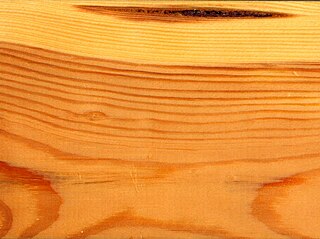 W
WSoftwood is wood from gymnosperm trees such as conifers. The term is opposed to hardwood, which is the wood from angiosperm trees.
 W
WTimber recycling or wood recycling is the process of turning waste timber into usable products. Recycling timber is a practice that was popularized in the early 1990s as issues such as deforestation and climate change prompted both timber suppliers and consumers to turn to a more sustainable timber source. Recycling timber is the environmentally friendliest form of timber production and is very common in countries such as Australia and New Zealand where supplies of old wooden structures are plentiful. Timber can be chipped down into wood chips which can be used to power homes or power.
 W
WA tree baler is a machine that wraps trees to allow for easier shipment and storage. Wrapped trees take up much less space and are less likely to be damaged during shipment. The aim of the device is to replace work that previously required hand-tying individual trees, most often used at commercial nurseries.
 W
WTropical timber may refer to any type of timber or wood that grows in tropical rainforests and tropical and subtropical moist broadleaf forests and is harvested there. Typical examples of worldwide industrial significance include the hardwoodsMahogany Teak Ebony Rosewood Narra Chloroxylon
 W
WWood warping is a deviation from flatness in timber as a result of stresses and uneven shrinkage. Warping can also occur in wood considered "dry", when it takes up moisture unevenly, or – especially – is allowed to return to its "dry" equilibrium state unevenly, too slowly, or too quickly. Many factors can contribute to wood warp: wood species, grain orientation, air flow, sunlight, uneven finishing, temperature – even cutting season and the moon's gravitational pull are taken into account in some traditions.